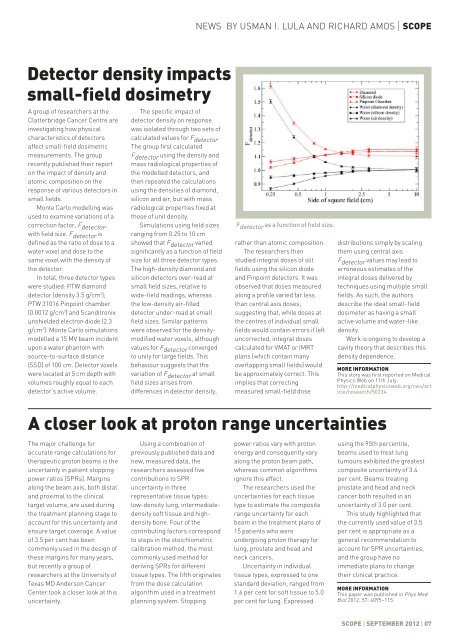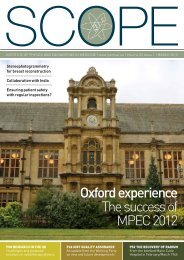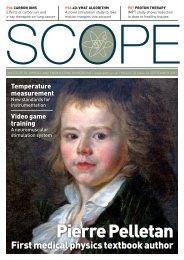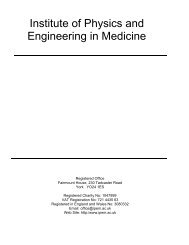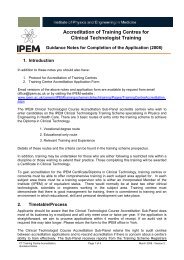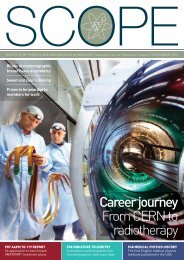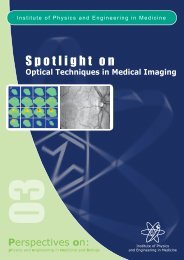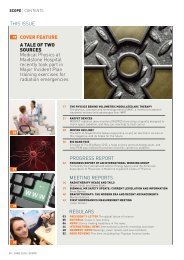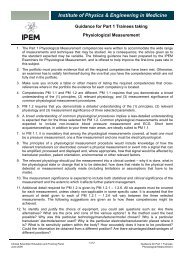Experience the Elekta Differ - Institute of Physics and Engineering in ...
Experience the Elekta Differ - Institute of Physics and Engineering in ...
Experience the Elekta Differ - Institute of Physics and Engineering in ...
You also want an ePaper? Increase the reach of your titles
YUMPU automatically turns print PDFs into web optimized ePapers that Google loves.
Detector density impacts<br />
small-field dosimetry<br />
A group <strong>of</strong> researchers at <strong>the</strong><br />
Clatterbridge Cancer Centre are<br />
<strong>in</strong>vestigat<strong>in</strong>g how physical<br />
characteristics <strong>of</strong> detectors<br />
affect small-field dosimetric<br />
measurements. The group<br />
recently published <strong>the</strong>ir report<br />
on <strong>the</strong> impact <strong>of</strong> density <strong>and</strong><br />
atomic composition on <strong>the</strong><br />
response <strong>of</strong> various detectors <strong>in</strong><br />
small fields.<br />
Monte Carlo modell<strong>in</strong>g was<br />
used to exam<strong>in</strong>e variations <strong>of</strong> a<br />
correction factor, F detector ,<br />
with field size. F detector is<br />
def<strong>in</strong>ed as <strong>the</strong> ratio <strong>of</strong> dose to a<br />
water voxel <strong>and</strong> dose to <strong>the</strong><br />
same voxel with <strong>the</strong> density <strong>of</strong><br />
<strong>the</strong> detector.<br />
In total, three detector types<br />
were studied: PTW diamond<br />
detector (density 3.5 g/cm 3 );<br />
PTW 31016 P<strong>in</strong>po<strong>in</strong>t chamber<br />
(0.0012 g/cm 3 ) <strong>and</strong> Sc<strong>and</strong>itronix<br />
unshielded electron diode (2.3<br />
g/cm 3 ). Monte Carlo simulations<br />
modelled a 15 MV beam <strong>in</strong>cident<br />
upon a water phantom with<br />
source-to-surface distance<br />
(SSD) <strong>of</strong> 100 cm. Detector voxels<br />
were located at 5 cm depth with<br />
volumes roughly equal to each<br />
detector’s active volume.<br />
The specific impact <strong>of</strong><br />
detector density on response<br />
was isolated through two sets <strong>of</strong><br />
calculated values for F detector .<br />
The group first calculated<br />
F detector us<strong>in</strong>g <strong>the</strong> density <strong>and</strong><br />
mass radiological properties <strong>of</strong><br />
<strong>the</strong> modelled detectors, <strong>and</strong><br />
<strong>the</strong>n repeated <strong>the</strong> calculations<br />
us<strong>in</strong>g <strong>the</strong> densities <strong>of</strong> diamond,<br />
silicon <strong>and</strong> air, but with mass<br />
radiological properties fixed at<br />
those <strong>of</strong> unit density.<br />
Simulations us<strong>in</strong>g field sizes<br />
rang<strong>in</strong>g from 0.25 to 10 cm<br />
showed that F detector varied<br />
significantly as a function <strong>of</strong> field<br />
size for all three detector types.<br />
The high-density diamond <strong>and</strong><br />
silicon detectors over-read at<br />
small field sizes, relative to<br />
wide-field read<strong>in</strong>gs, whereas<br />
<strong>the</strong> low-density air-filled<br />
detector under-read at small<br />
field sizes. Similar patterns<br />
were observed for <strong>the</strong> densitymodified<br />
water voxels, although<br />
values for F detector converged<br />
to unity for large fields. This<br />
behaviour suggests that <strong>the</strong><br />
variation <strong>of</strong> F detector at small<br />
field sizes arises from<br />
differences <strong>in</strong> detector density,<br />
ra<strong>the</strong>r than atomic composition.<br />
The researchers <strong>the</strong>n<br />
studied <strong>in</strong>tegral doses <strong>of</strong> slit<br />
fields us<strong>in</strong>g <strong>the</strong> silicon diode<br />
<strong>and</strong> P<strong>in</strong>po<strong>in</strong>t detectors. It was<br />
observed that doses measured<br />
along a pr<strong>of</strong>ile varied far less<br />
than central axis doses,<br />
suggest<strong>in</strong>g that, while doses at<br />
<strong>the</strong> centres <strong>of</strong> <strong>in</strong>dividual small<br />
fields would conta<strong>in</strong> errors if left<br />
uncorrected, <strong>in</strong>tegral doses<br />
calculated for VMAT or IMRT<br />
plans (which conta<strong>in</strong> many<br />
overlapp<strong>in</strong>g small fields) would<br />
be approximately correct. This<br />
implies that correct<strong>in</strong>g<br />
measured small-field dose<br />
distributions simply by scal<strong>in</strong>g<br />
<strong>the</strong>m us<strong>in</strong>g central axis<br />
F detector values may lead to<br />
erroneous estimates <strong>of</strong> <strong>the</strong><br />
<strong>in</strong>tegral doses delivered by<br />
techniques us<strong>in</strong>g multiple small<br />
fields. As such, <strong>the</strong> authors<br />
describe <strong>the</strong> ideal small-field<br />
dosimeter as hav<strong>in</strong>g a small<br />
active volume <strong>and</strong> water-like<br />
density.<br />
Work is ongo<strong>in</strong>g to develop a<br />
cavity <strong>the</strong>ory that describes this<br />
density dependence.<br />
A closer look at proton range uncerta<strong>in</strong>ties<br />
The major challenge for<br />
accurate range calculations for<br />
<strong>the</strong>rapeutic proton beams is <strong>the</strong><br />
uncerta<strong>in</strong>ty <strong>in</strong> patient stopp<strong>in</strong>g<br />
power ratios (SPRs). Marg<strong>in</strong>s<br />
along <strong>the</strong> beam axis, both distal<br />
<strong>and</strong> proximal to <strong>the</strong> cl<strong>in</strong>ical<br />
target volume, are used dur<strong>in</strong>g<br />
<strong>the</strong> treatment plann<strong>in</strong>g stage to<br />
account for this uncerta<strong>in</strong>ty <strong>and</strong><br />
ensure target coverage. A value<br />
<strong>of</strong> 3.5 per cent has been<br />
commonly used <strong>in</strong> <strong>the</strong> design <strong>of</strong><br />
<strong>the</strong>se marg<strong>in</strong>s for many years,<br />
but recently a group <strong>of</strong><br />
researchers at <strong>the</strong> University <strong>of</strong><br />
Texas MD Anderson Cancer<br />
Center took a closer look at this<br />
uncerta<strong>in</strong>ty.<br />
Us<strong>in</strong>g a comb<strong>in</strong>ation <strong>of</strong><br />
previously published data <strong>and</strong><br />
new, measured data, <strong>the</strong><br />
researchers assessed five<br />
contributions to SPR<br />
uncerta<strong>in</strong>ty <strong>in</strong> three<br />
representative tissue types:<br />
low-density lung, <strong>in</strong>termediatedensity<br />
s<strong>of</strong>t tissue <strong>and</strong> highdensity<br />
bone. Four <strong>of</strong> <strong>the</strong><br />
contribut<strong>in</strong>g factors correspond<br />
to steps <strong>in</strong> <strong>the</strong> stoichiometric<br />
calibration method, <strong>the</strong> most<br />
commonly used method for<br />
deriv<strong>in</strong>g SPRs for different<br />
tissue types. The fifth orig<strong>in</strong>ates<br />
from <strong>the</strong> dose calculation<br />
algorithm used <strong>in</strong> a treatment<br />
plann<strong>in</strong>g system. Stopp<strong>in</strong>g<br />
NEWS BY USMAN I. LULA AND RICHARD AMOS | SCOPE<br />
F detector as a function <strong>of</strong> field size.<br />
power ratios vary with proton<br />
energy <strong>and</strong> consequently vary<br />
along <strong>the</strong> proton beam path,<br />
whereas common algorithms<br />
ignore this effect.<br />
The researchers used <strong>the</strong><br />
uncerta<strong>in</strong>ties for each tissue<br />
type to estimate <strong>the</strong> composite<br />
range uncerta<strong>in</strong>ty for each<br />
beam <strong>in</strong> <strong>the</strong> treatment plans <strong>of</strong><br />
15 patients who were<br />
undergo<strong>in</strong>g proton <strong>the</strong>rapy for<br />
lung, prostate <strong>and</strong> head <strong>and</strong><br />
neck cancers.<br />
Uncerta<strong>in</strong>ty <strong>in</strong> <strong>in</strong>dividual<br />
tissue types, expressed to one<br />
st<strong>and</strong>ard deviation, ranged from<br />
1.6 per cent for s<strong>of</strong>t tissue to 5.0<br />
per cent for lung. Expressed<br />
MORE INFORMATION<br />
This story was first reported on Medical<br />
<strong>Physics</strong> Web on 11th July:<br />
http://medicalphysicsweb.org/cws/art<br />
icle/research/50234<br />
us<strong>in</strong>g <strong>the</strong> 95th percentile,<br />
beams used to treat lung<br />
tumours exhibited <strong>the</strong> greatest<br />
composite uncerta<strong>in</strong>ty <strong>of</strong> 3.4<br />
per cent. Beams treat<strong>in</strong>g<br />
prostate <strong>and</strong> head <strong>and</strong> neck<br />
cancer both resulted <strong>in</strong> an<br />
uncerta<strong>in</strong>ty <strong>of</strong> 3.0 per cent.<br />
This study highlighted that<br />
<strong>the</strong> currently used value <strong>of</strong> 3.5<br />
per cent is appropriate as a<br />
general recommendation to<br />
account for SPR uncerta<strong>in</strong>ties,<br />
<strong>and</strong> <strong>the</strong> group have no<br />
immediate plans to change<br />
<strong>the</strong>ir cl<strong>in</strong>ical practice.<br />
MORE INFORMATION<br />
This paper was published <strong>in</strong> Phys Med<br />
Biol 2012; 57: 4095–115.<br />
SCOPE | SEPTEMBER 2012 | 07


